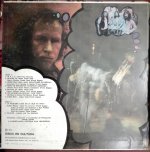If it is not cross distortion, could it be total harmonic distortion THD ? Or maybe the distortion by transistory impulses ITD ? Maybe I am repeating some kind of distortion here, I am somewhat lazy to look for the correct name, I admit it, but the real fact is that they sound awful when the volume goes up. All transistor amplifiers (I haven't had class A) that went through my hands, sounded horrible at high volumes. On the other hand, neither the PP with 6BQ5 that I built more than fifty years ago (and unfortunately I sold for coins when the transistor came out, announced with drums and cymbals like the audio panacea) nor my current Prima Luna have that problem. Watch this : Other results of the study yielded these results: The bulb-based system improved the emotional status of the participants (enjoy the music) with an extraordinary figure of 187% on the transistor system. The bulb-based system improved mental status (less tension, more relaxation) by more than 102% over solid state based audio. 30% of the participants felt worse when listening to the transistor system and not a single person felt worse after listening to the bulb system. Who wants to read more in depth about this experiment can read it here. God is in the Nuances Page 3 | Stereophile.comCrossover distortion is usually more audible at lower volume levels.
Last edited:
You cannot realistically expect listening to any YouTube video will tell you what something really sounds like.
Is that from experience, or guessing?
This test is for amp quality. Recording quality is irrelevant. Actually the amp should tell when there is issue with the recording. Those who have good ears can cheat by using headphone though. But using transparent amp, the difference is obvious that everybody can easily hear the difference.
Is that from experience, or guessing?
Fact.
What we are listening to thru YouTube is convolved with a whole array of things that are not the intended DUT, that there is guarantee of the loss of any nuance. And ultimate fidelity. What comes out at this end is a caricature of what you hear in your listening room.
dave
What we are listening to thru YouTube is convolved with a whole array of things that are not the intended DUT, that there is guarantee of the loss of any nuance.
Doesn't everybody know that? How about the two files I mentioned, do they sound similarly bad/good through your amps and speakers?
Doesn't everybody know that? How about the two files I mentioned, do they sound similarly bad/good through your amps and speakers?
Seems as though Suzanne Vega is recorded with more gain.
Both suffer from vocal scruff and typical YouTube sound.......which is surprisingly good for what it is, just not reference material by any means.
And different audio engineers, probably different mic setups, etc.. no wonder they sound different
Is it your speakers?they sound awful when the volume goes up.
It could be lack of distortion and you, like many, prefer the distortions characteristic of valve amps.If it is not cross distortion, could it be total harmonic distortion THD ? Or maybe the distortion by transistory impulses ITD ?
2 is wrong, the ear find the sound high pitched when it is played softer, so many amps have bass boost at low volume to compensate the ear curve.
I believe your argument is not right. The "ear curve" is there no matter if we're listening to reproduced sound or natural sounds of things that are happening in reality, right here and now. Compensation of the "ear curve" would therefore be wrong, no matter what kind of sounds are reproduced by the audio playback system. The idea of "clean flat response" therefore seems right to me.
However, I am not sure how "you should not get an unpleasant audio experience while you turn up the volume" relates to the "clean flat response" part of rule #2. Turning up the playback volume usually does not mess too much with the "response curve".
Turning up the volume tends to increase non-linear distortion. Keeping non-linear distortion at bay is a good idea. However, it is very difficult to say which type of measure is most meaningful to quantify non-linear distortion in terms of "how good does it sound". The plain old THD number is probably not the best indicator.
That said, rules #1, #3 and #4 make a lot of sense to me.
Yes, but....it's a compensation for when the sound is being reproduced at a lower level than would happen in reality, in this case, the sound level used during mixing.I believe your argument is not right. The "ear curve" is there no matter if we're listening to reproduced sound or natural sounds of things that are happening in reality, right here and now. Compensation of the "ear curve" would therefore be wrong, no matter what kind of sounds are reproduced by the audio playback system. The idea of "clean flat response" therefore seems right to me.
IMO, when listening to a system with uncompromised dynamics, and especially obvious when fading is employed, this effect is demonstrated to be unrelated to what would be expected by studying the equal loudness curves. The response extremes just don't collapse under the signal level the way loudness controls make out.
Personally I don't use them, I think psychoacoustics comes into play, we tend to fill in the lower frequencies from the harmonics.
My Guide for Best-in-class
Yes, hands clapping is highly affected by this "x" issue. But the effect is of course not only to claps but to all sound. This issue with claps is easy to identify but not as disturbing as the same issue with human voices imo.
If I had to add to this thread, my single guide for best-in-class system 🙂D) it will be different with others, but believe me, when everything critical is right with our system, then we will start to sing along.
I like when clapings of the venues (which is a relativly wide band "noise") are acurate in my listening 😱!
Yes, hands clapping is highly affected by this "x" issue. But the effect is of course not only to claps but to all sound. This issue with claps is easy to identify but not as disturbing as the same issue with human voices imo.
If I had to add to this thread, my single guide for best-in-class system 🙂D) it will be different with others, but believe me, when everything critical is right with our system, then we will start to sing along.
Ops, maybe, after all the speakers are the most distorted components of the chain, right ?Is it your speakers?
😀
The identification of individual applause in the middle of the global mass is a way of assessing the quality of the speakers.Yes, hands clapping is highly affected by this "x" issue. But the effect is of course not only to claps but to all sound. This issue with claps is easy to identify but not as disturbing as the same issue with human voices imo.
The identification of individual applause in the middle of the global mass is a way of assessing the quality of the speakers.
Never thought of that. Sounds right
That is because the applause has a large number of transient impulses in the middle range, all simultaneously .... we must try to individualize them, not listen to a mass of amorphous sound of many applause. The voices also serve to assess the midrange, of course, but the trick with the applause is to be able to perceive the separation of the different sound sources (clapping hands) while listening. I leave you an example, look for 36.15 minutes, of course you should find another sound source better than YT, as Planet10 says, YT leaves much to be desired, I know it is compressed, although I don't know which algorithm ... I keep this LP in perfect condition, but SPfy sounds more natural and with more details to my ears. Of course, the capsule is an Ortofon Red, nothing special ... Also, in the attachment of Frank Zappa, if you want to fully enjoy (to my liking) it is also a recording to evaluate many instruments, from the classics as a "timbale", typical of a symphony orchestra, to an electric guitar typical of the rock of that moment. YouTube P.S: I always liked the fusion between "serious" and "transgressive" music, Deep Purple, Emerson L And P, etc., etc.Never thought of that. Sounds right
If you know that why go thru the effort ?Doesn't everybody know that?
dave
But the kinds of distortions are different. And Geddes has shown that the usual measures we take for distortion measurement ar enot very useful.Ops, maybe, after all the speakers are the most distorted components of the chain, right ?
dave
Although I did hear claims of 'sounds worse at higher levels'. Unless an amp is clipping, and this is not difficult to be sure of, then speakers become worthy of interest, and not necessarily for non-linear distortion.
Ops, maybe, after all the speakers are the most distorted components of the chain, right ?
Yes, IMD can be a major issue causing relatively high audible distortion in speakers
That comment goes in the direction that I pointed out, and that after all if you remove a speaker from its optimal range of work, you can reach a 10% distortion proper to it, so all zeros after the comma in the Amplifier measurements do not seem so relevant. And for the same reason the "high" distortion of a valve amplifier does not seem relevant .But the kinds of distortions are different. And Geddes has shown that the usual measures we take for distortion measurement ar enot very useful.
dave
Hoffman's Law! Don't pretend to hear the real sound of those patches on a 6, 8 or 10 inch speaker.Also, in the attachment of Frank Zappa, if you want to fully enjoy (to my liking) it is also a recording to evaluate many instruments, from the classics as a "timbale", typical of a symphony orchestra, to an electric guitar typical of the rock of that moment.
Minimum 12! and if it is more, better ! 😉
I just heard this masterpiece once again!
They have to give it a try, FZ is watching them ...
Not sure if from heaven or hell .....🙄
Attachments
- Status
- Not open for further replies.
- Home
- Member Areas
- The Lounge
- I think I've condensed in only 4 Laws the guideline for the best-in-class audio chain



